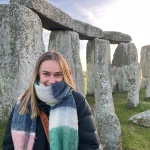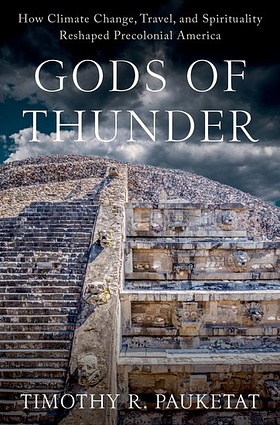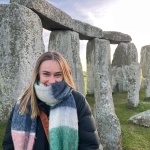Join World History Encyclopedia as they chat with Tim Pauketat all about his new book Gods of Thunder: How Climate Change, Travel, and Spirituality Reshaped Precolonial America, published by Oxford University Press.
Kelly: Thank you so much for joining me today. I am so excited to talk to you about your new book. Let us start off with what your book is all about.
Tim: This book is a big history. It tries to recast what that means in human and nonhuman terms. That is, I am seeking in this book to think through climate change and how people live with climate change in the present by looking at the past, especially this one really important episode that affects the entire Northern Hemisphere. It is better known in Europe, but it is also really important in North America, and that is, of course, the medieval climate anomaly, sometimes called a warm period.
Kelly: Can you tell us a little bit about what that medieval anomaly is?
Tim: Sure. Around 800 CE or so, the climate around the Northern Hemisphere tended to warm up a bit, at least 1 °C, maybe 2. It really varies depending on where one was back then in the Northern Hemisphere. In some places, it even got a little cooler, but mostly it got warmer. And along with that warming trend, in some places, it got wetter, and in some places, it became much drier. Both in terms of temperature and in terms of precipitation, it has a very profound impact on human civilizations, as you might imagine. This lasts until about 1300 CE or so when the trend then turns away from being warm and becomes much cooler around the world. That is the Little Ice Age.
Kelly: Right. How did you get this information about this climate change? Is it written text? Is it through archaeology?
Tim: Well, certainly, climatologists study this and other periods in the past, and they have information from everything from ice cores to other deposits in other parts of the world from this time period, natural deposits. Archaeologists have a lot of information. Again, depending on where you are in North America, this is a very well-studied period because this is when some of the classic Mesoamerican and Southwestern and Mississippi Valley civilizations emerge, all more or less simultaneously in this period. Archaeologists do not draw so much on text, although there are a few, mostly Maya texts, short political statements from leaders at the time. By and large, we rely on the remains, both in terms of monuments and cities, how they were built, when they were built, how they were deconstructed, and even more so on the residue of daily life, what people were doing, tools, what they were eating, the debris from meals and the like.
Kelly: So, what they were eating and the tools they were using shifted during this time to adapt to the changing climate?
Tim: It is more like the distribution of people across the landscape. Whether you are looking at Europe and Asia or at North America, it changes, sometimes dramatically. And so, people move. There is a trend towards just more travel in this time period as people were able to or sought to understand what was happening in the world, and so they get on the road, and they go other places to see what is happening here or there. It is all part of a search for knowledge to understand the larger trends that they were seeing, among the most significant being the temperature and precipitation that either caused forced changes on some people or enabled certain changes for other people. By that, I mean, one of these big changes that has been known for many years is that, in Mesoamerica, there is a collapse of certain well-known civilizations. The classic Maya is a really well-known example, and that collapse starts a little before the year 800 and really becomes complete by the end of the 800s. Most people think that to some extent that is climate-related. Turns out that there are other climate-related changes like that, forcing other kinds of changes elsewhere across the continent. Again, some of them pushing people, some of them pulling people into new social and political arrangements. And at that scale – societies – it is pretty easy to see, archaeologically.
Kelly: Definitely. That is pretty incredible that something like climate can make such profound changes in cultures and civilizations. So, obviously, you are tackling quite a large concept. Why did you decide to write this book?

Tim: I probably had three or four different motives. One was that, as somebody who studies Indigenous North America before European contact, I have, for many years, maybe much of my career, thought that archaeologists have tended to misinterpret what people's motivations were for changes, including ones involving climate. This book is an attempt to show how people's motivations 1,000 years ago or so were different and not what we typically expect – 'we' being the Western intellectual world. I think it is important to rethink how people can engage climate change, in part because we need to think through how are we going to be engaging climate change as we go forward, and we need to expand our vision a little bit about the possibilities. That is probably the major reason that I wanted to write this book.
Kelly: What were the other reasons, if you do not mind me asking?
Tim: No, I do not mind. I had just come off of writing a North American textbook. I have taught North American archaeology for most of my career. In textbooks and in courses which are restricted to a semester, let us say, 13 or 14 weeks, this is all part of the intellectual tradition of the United States and the West generally, but you are not really supposed to think about the effects of Mesoamerica, which is the area mostly in Mexico, on the people north of the US-Mexico border. Even in writing this textbook, we were, my co-author and I were forced by the publisher to narrow the focus and only deal with people mostly north of the US-Mexico border. I know the story; the really interesting story and the cause-and-effect of this big history has to include both sides of that border. I wanted to address that in another book beyond that textbook.
Kelly: Yeah, absolutely. It only makes sense that it did not only affect one region, it would have affected a larger area. So it is great that you got that opportunity to expand the borders of the idea.
Tim: There is a third reason as well. It is a bit of an elaboration of the first one, and I will lay it out for you as briefly as I can. It is a theoretical development in archaeology that actually originated with indigenous people. That is, the way that indigenous people, especially in North America, relate to the world is different in many ways from the way other people relate to their world. In archaeology, there has been an attempt to blend the two together and to think about new ways of understanding history. This book then is an attempt to overcome a fairly narrow reading of history as only human. All the players are human, and the environment is outside of people, and it is all about human motivations, strategies, and adaptations. What I wanted to do was allow other than human forces – wind, water, and the things we reduce as climate – to be a part of the telling of this bigger history.
Kelly: That is incredibly fascinating. While you were working on this book and perhaps on the textbook prior, during that research, what was one of the more fascinating or surprising or interesting things that you came across?
Tim: I had a good sense of the generalities of cross-cultural datasets. I knew I could write a book that examined a series of lines of evidence and there would be something interesting to say. I did not really appreciate how consistent the important changes that happened from the Maya around 800 CE up through Mexico, up into the American Southwest, and then over into the Southern Plains and up the Mississippi Valley were. There is a real consistency to the changes. There are religious changes. There are things probably being driven by religious movements, or sometimes people will call these cults.
What you see happening in the south is in many ways very much like what happens in the north all the way up the Mississippi Valley in terms of the specifics of the religious changes. It became clearer as I was writing this that there probably were a set of gods that were being worshipped. In a way, there was a movement that these gods were a part of that was spreading, and that consistency even tracks with radiocarbon dates. It spreads and you can see the spread happening just by dating things. So it starts at 800 or so in the south and really it culminates at about 1050, 1100 in the far north. You could just line up the dates and say, "Oh yeah, there is some big history here that is causing all of these consistent changes to happen."
Kelly: So you can literally see the movement of the cult with the climate?
Tim: Yes. The degree to which you can do that was a surprise even to me.
Kelly: That is incredible. I was going to actually ask if there was any ritual or religious shift because of the climate and because of the changes in their environment.
Tim: Yeah, it is very much climate-driven, but there are different kinds of climate change. Yet, the same gods are involved because it is the gods that bring rain. Farmers and all these people are farming maize or corn. Corn is a very water-sensitive plant. So if there is a drought, that is bad, so people will need to appeal to the gods to try to correct that. If there are floods and just too much rain, that is also bad for corn crops, and so people will need to appeal to the gods to mitigate that excess. It is funny that whatever the climate change is, whatever direction the climate is changing, it is the same gods that are seemingly invoked to try to help people deal with those changes.
Kelly: It is either 'please more water' or 'please less water', but it is still the same god. What evidence did the cults leave? Is it ritual objects? How did you track the movement of the cult?
Tim: In this book, I was mostly concerned with tracking ritual practices. Those practices show up as a new circular temple. These are – and I say it is a temple – primarily circular platform mounds or pyramids with a circular building on top. A couple of millennia ago, they first appeared in Mesoamerica in restricted locations, but when this climate change happens, they very rapidly spread from the Maya world all across Mexico and then up into the north. These are the things that are being dated now. Especially when you get in the north, they are completely anomalous. No one was building circular pyramids, like truncated cones with circular buildings on top. Archaeologists have looked at the buildings in these various locations around North America, and you can see that what was going on inside is some similar set of rituals involving water or the animals or beings associated with water. That often plays out as shells, mollusk shells, as ornaments or as things decorating walls or roofs. That is the primary way I track it. Now, other people have in the past noted already, before I ever got to this book, that there are similarities in the mythic histories or the gods that were first described, especially by Europeans, conquistadors, and then the explorers in the north. They describe the gods that people told them about. The ones that really matter for what I am talking about are thunder gods – wind-that-brings-rain gods.
Kelly: Hence the name, Gods of Thunder. That is incredible that you can track it so ... Not easily, but there are so obvious and consistent things throughout the landscape that you can follow.
Tim: Yes. This is not something that most people in other parts of the world, outside of tribal descendants in North America or archaeologists who more routinely work with tribal descendants, appreciate, but there was actually this major historical development that played out during the medieval period, just like other medieval changes were playing out in Eurasia. And it affected hundreds of thousands, millions of people. That is important, and people do not even know that it happened, by and large.
Kelly: It is important. And now, hopefully, more people will know, which is, I am assuming, another reason to write this book, to shed light on these topics. So probably the last question is, what is something that you really want people to know either about your book or about the topic as a whole?
Tim: I think there are lessons in history that we need to appreciate. Not just because we do not want to repeat the bad things of history, but because we – and I am using it very liberally – tend to already think we know the way the world works. Without understanding the variety in history, like the various people and the way they did things that were maybe very unlike other people here or there. Without that understanding, a global appreciation of history, we are missing a big part of the human story that should inform our ideas, our plans, and our policies about the future. That is the ultimate reason that I think this history is important, and that is what I would like people to appreciate after they read a book like this.
Kelly: Thank you so much for joining me today. It has been a pleasure talking to you about your new book, Gods of Thunder.
Tim: You are very welcome. Thank you.











